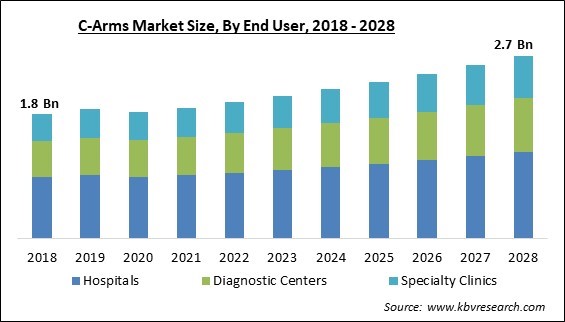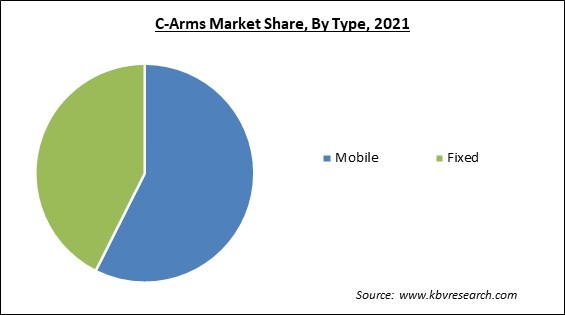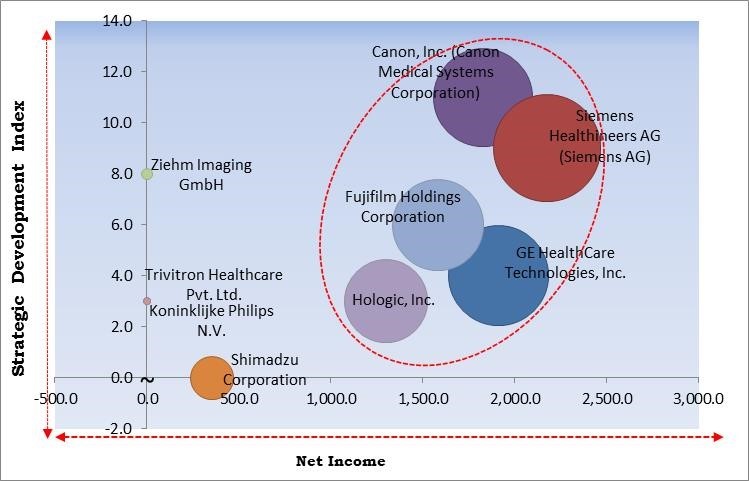
The Global C-Arms Market size is expected to reach $2.7 billion by 2028, rising at a market growth of 5.0% CAGR during the forecast period.
The C-Arm is a flexible medical imaging tool that may be utilized in various clinic operating rooms. The development of the device has resulted from X-ray technology, and the name of the device comes from the C-shaped arm that joins the X-ray detector and X-ray source. A flat panel detector image intensifier and a generator designated X-ray source are both parts of C-Arms. It is frequently used for intra-operative imaging in surgery, orthopedics, vascular surgery, cardiology, and traumatology.

The tool gives the surgeon real-time, high-resolution X-ray images to check on the patient's condition at any stage of the procedure. A C-Arm device is a scanner intensifier for imaging. When performing surgical, orthopedic, and emergency care operations, C-Arms, which have radiographic capabilities, are generally employed for intraoperative imaging. When used for fluoroscopy, the C-Arm is also frequently referred to as a portable x-ray.
Fluoroscopy techniques are medical practices that enable real-time image capture inside certain body sections. X-rays are released by the generator and enter the patient's body. The image detector or intensifier transforms the x-rays into a visual image on the C-Arm monitor. The c-shaped connection allows for movement in all directions, including horizontally, vertically, as well as around the swivel axis, enabling practically any angle to create an x-ray image of the patient.
Real-time imaging provided by C-Arms enables medical professionals to see a patient's inside organs while performing surgery. As a result, they may be able to identify illnesses more precisely and carry out procedures more securely. The portability of C-Arms makes it simple to transfer them to the operating room.
Significant delays were made in non-urgent medical procedures due to major interruptions in their respective supply chains and industrial processes brought on by several precautionary lockdowns. Demand and supply in the market were downgraded by supply chain problems. The situation became even worse as a result of significant disruptions to their individual industrial and supply-chain operations brought on by numerous precautionary lockdowns. However, elective surgery waiting times decreased by as much as one-third, and the elective surgery rate increased by one-fifth following the lockdown, offering opportunities for growth. Therefore, the COVID-19 pandemic had a negative impact on the C-Arms market.
Seventeen million people worldwide succumb to an NCD before they turn 70 each year. Out of all NCD deaths, 77% occur in low- and middle-income nations, accounting for 86% of these deaths. Chronic respiratory diseases (4.1 million), cancers (9.3 million), and diabetes account for most NCD deaths or 17.9 million people annually. Also, the increased number of traffic incidents and other orthopedic injuries expedites the requirement for C-Arms. Therefore, as the prevalence of these diseases and injuries rises, it will propel the demand for efficient and fast diagnostic devices. This, in turn, drives the growth of the C-Arms market.
Certain other developments like vascular 3D image guiding, movable mini C-Arm, 3-D surgical imaging system, and multidisciplinary functionality are all possible due to the increased R&D. Furthermore, the increasing FDA approval rates of these developments have further prompted manufacturers to innovate. For example, the FDA has approved the Cios Flow, a device having multidisciplinary versatility, which ensures excellent system usage and capacity. Furthermore, its features allow for the simpler, more effective operation to enhance patient care in the OR. Hence, the rising R&D efforts by the market participants promote the market's growth.
High expenditures associated with R&D capabilities, constrained infrastructure facilities, and expensive maintenance and installation costs are anticipated to hinder the demand for fixed and mobile C-Arms. Also, the market is anticipated to face challenges from the penetration of technology in developing nations as well as a lack of suitable reimbursement scenarios. Furthermore, the development of fixed and mobile C-Arms is further hampered by technological problems, a high-risk aspect related to emergency cases, a lack of qualified doctors in developing and undeveloped areas, and an inadequate infrastructure in many nations. Therefore, the expansion of the C-Arms market is anticipated to be threatened by these factors throughout the forecast period.
Based on type, the C-Arms market is categorized into mobile and fixed. The fixed segment procured a considerable growth rate in the C-Arms market in 2021. The segment's growth is aided by the Centers for Medicare and Medicaid Services (CMS) approval of specific cardiovascular procedures. In addition, fixed C-Arm uses have changed due to ongoing technological and clinical developments. In addition to cardiology and radiology departments, they can be put in surgery centers with access to various medical specialties, where conventional film X-rays were formerly employed to deliver imaging for surgeons

On the basis of application, the C-Arms market is divided into cardiology, gastroenterology, neurology, orthopedic & trauma, oncology, and others. The neurology segment witnessed a promising growth rate in the C-Arms market in 2021. For directing minimally invasive procedures and tracking results, the C-Arm system's data is crucial. For example, in neurosurgery, accuracy is crucial since even the smallest modification can have a big impact on the clinical and functional outcomes of the patient. As a result, precise imaging of the brain anatomy, which is necessary for treatments, can be provided using high-resolution C-Arm technology.
Based on end user, the C-Arms market is segmented into hospitals, diagnostic centers, and specialty clinics. The hospitals segment garnered the maximum revenue share in the C-Arms market in 2021. Hospitals are the principal end users of C-Arms systems and the primary customers of C-Arms device makers, which accounts for the segment's growth. Mobile imaging is required for several medical procedures, such as orthopedic, vascular, and gastrointestinal surgeries, which drives the need for C-Arms equipment in hospitals. As the frequency of interventional therapies rises, so does the demand for medical imaging.
| Report Attribute | Details |
|---|---|
| Market size value in 2021 | USD 1.9 Billion |
| Market size forecast in 2028 | USD 2.7 Billion |
| Base Year | 2021 |
| Historical Period | 2018 to 2020 |
| Forecast Period | 2022 to 2028 |
| Revenue Growth Rate | CAGR of 5% from 2022 to 2028 |
| Number of Pages | 216 |
| Number of Table | 374 |
| Report coverage | Market Trends, Revenue Estimation and Forecast, Segmentation Analysis, Regional and Country Breakdown, Competitive Landscape, Companies Strategic Developments, Company Profiling |
| Segments covered | End User, Type, Application, Region |
| Country scope | US, Canada, Mexico, Germany, UK, France, Russia, Spain, Italy, China, Japan, India, South Korea, Singapore, Malaysia, Brazil, Argentina, UAE, Saudi Arabia, South Africa, Nigeria |
| Growth Drivers |
|
| Restraints |
|
On the basis of region, the C-Arms market is analyzed across North America, Europe, Asia Pacific, and LAMEA. The North America segment acquired the highest revenue share in the C-Arms market in 2021. The emergence of several significant important players and the rapid advancement of technology in the region fuel market expansion. In addition, the increased demand for minimally invasive surgical treatments, the quick expansion of the elderly population, the introduction of technologically advanced C-Arms devices, and improved healthcare infrastructure are all important factors propelling the regional C-Arms market.
Free Valuable Insights: Global C-Arms Market size to reach USD 2.7 Billion by 2028

The major strategies followed by the market participants are Product Launches. Based on the Analysis presented in the Cardinal matrix; Canon, Inc. (Canon Medical Systems Corporation), Siemens Healthineers AG (Siemens AG), Hologic, Inc., Fujifilm Holdings Corporation, and GE HealthCare Technologies, Inc. are the forerunners in the C-Arms Market. Companies such as Trivitron Healthcare Pvt. Ltd. and Ziehm Imaging GmbH are some of the key innovators in C-Arms Market.
The market research report covers the analysis of key stake holders of the market. Key companies profiled in the report include Canon, Inc. (Canon Medical Systems Corporation), Siemens Healthineers AG (Siemens AG), Koninklijke Philips N.V., GE HealthCare Technologies, Inc., Fujifilm Holdings Corporation, Shimadzu Corporation, Hologic, Inc., Ziehm Imaging GmbH, Trivitron Healthcare Pvt. Ltd., and Nanjing Prelove Medical Equipment Co., Ltd.
By End User
By Type
By Application
By Geography
The global C-Arms Market size is expected to reach $2.7 billion by 2028.
Rising prevalence of acute and chronic diseases and disorders, and injuries are driving the market in coming years, however, Low return on investment and high cost of R&D restraints the growth of the market.
Canon, Inc. (Canon Medical Systems Corporation), Siemens Healthineers AG (Siemens AG), Koninklijke Philips N.V., GE HealthCare Technologies, Inc., Fujifilm Holdings Corporation, Shimadzu Corporation, Hologic, Inc., Ziehm Imaging GmbH, Trivitron Healthcare Pvt. Ltd., and Nanjing Prelove Medical Equipment Co., Ltd.
The Mobile segment is leading the Global C-Arms Market by Type in 2021 thereby, achieving a market value of $1.6 billion by 2028.
The North America market dominated the Global C-Arms Market by Region in 2021, and would continue to be a dominant market till 2028; thereby, achieving a market value of $924.2 Million by 2028.
Our team of dedicated experts can provide you with attractive expansion opportunities for your business.
